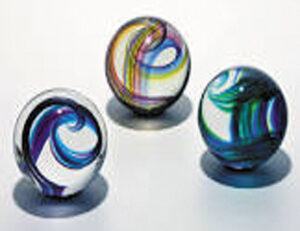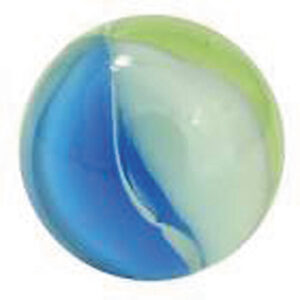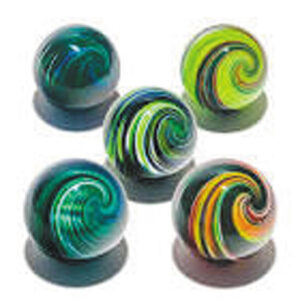 By Robert Reed
By Robert Reed There is still a bit of everlasting joy in a jar full of old marbles, sitting snugged away on a shelf and holding warm memories as well as vivid colors.
Marbles, of course, have been treasured by children for centuries, dating to the days of Egypt and later to Rome, where Emperor Augustus Caesar himself is said to have left the royal grounds to join youngsters in the streets shooting marbles.
Besides Egypt and Rome, marbles were also the delight of children in ancient Greece, whence comes the word “marble” itself, which means a polished white agate.
Marbles were introduced into the American colonies by the Dutch, who identified shooters as taws, and considered anything smoothed from cobalt, onyx, jasper, jade or marble to be fair game.
By the 1770s a book entitled The Pretty Pocket Book offered some references to marbles, playing and endurance:
Marbles
Knuckle down to your Taw.
Aim well, shoot away
Keep out of the Ring
You’ll soon learn to play.
Still another children’s book, published in New York in 1829, suggested that taws of red marble were the choice, and second best were those of yellow stone with bits of brown and black. The least desirable, according to the book’s ratings, were the Dutch marbles of glazed clay.
 No less than William McGuffey created a conversation in his 1837 Third Electric Reader involving a horse owner and a boy who had saved a runaway. The man asked if the boy had playthings such as “nine-pins, tops, wooden horses, and marbles.” The lad replied he had none.
No less than William McGuffey created a conversation in his 1837 Third Electric Reader involving a horse owner and a boy who had saved a runaway. The man asked if the boy had playthings such as “nine-pins, tops, wooden horses, and marbles.” The lad replied he had none. Up through the middle of the 19th century, marbles were imported into this country from Europe. A vast majority of them were sulphide marbles produced by glassmakers in the Lausca region of Germany. During the Civil War, soldiers carried such marbles and a small board to play the game of Solitaire, jumping them until only one remained.
However, the industrial revolution left its mark on marble production as well as most other items of mass manufacture. As early as the 1880s, marbles were being made in the United States in general, and in the potteries of Ohio, Indiana, Vermont and Pennsylvania in particular. One of the leading manufacturers in Ohio was Samuel C. Dyke of South Akron. Brown and blue glazed clay marbles were first offered, and finally the more colorful agates or “aggies.”
By the 1890s aggies were being produced in numbers in the U.S., and even offered for sale by the prosperous Montgomery Ward and Company. Still another retail outlet of the gay nineties advertised such standards as “Jaspies, Brandies, Bowlers” and a host of others.
Yet the best was still to come.
In the early 1900s, the firm M.F. Christensen became firmly established in Navarre, Ohio. They were one of the first to use marble-making machines to fully compete with the German imports. By 1911 the Akro Agate Company had emerged to not only encompass machine manufacture, but to include specific changes from only bulk sales to department stores to the expanded selling of small individual packages in various places. After the end of World War I, the U.S. moved to the lead of marble manufacture, but both Americans and Germans had abandoned handmade types for the mass production of machines to meet the demand.
 By this time the colorful playthings were everywhere in the U.S. Note the authors of Greenburg’s Guide to Marbles, “Schoolyards, playgrounds, city sidewalks. Playing marbles was one of the great American pastimes.” Write Mark Randall and Dennis Webb: “During the late 1920s and early 1930s, business was booming—the game of marbles was a given fact of American life. The foreign competition was long gone, and did not trouble the U.S. marble makers for many years. The competition on the home front was fierce enough: After a series of court battles over patent infringements, the field was thrown wide open to newcomers by the ruling that certain crucial patents were invalid, and that the technology that had previously been a monopoly was now available to everyone.”
By this time the colorful playthings were everywhere in the U.S. Note the authors of Greenburg’s Guide to Marbles, “Schoolyards, playgrounds, city sidewalks. Playing marbles was one of the great American pastimes.” Write Mark Randall and Dennis Webb: “During the late 1920s and early 1930s, business was booming—the game of marbles was a given fact of American life. The foreign competition was long gone, and did not trouble the U.S. marble makers for many years. The competition on the home front was fierce enough: After a series of court battles over patent infringements, the field was thrown wide open to newcomers by the ruling that certain crucial patents were invalid, and that the technology that had previously been a monopoly was now available to everyone.” Besides the attractive agates, there were the sparkling sulphides of clear glass with frosted flowers, animals or other figures encased inside. The sulphides are some of the rarest and most-valued of marbles today, and frequently command prices of $50 to $150. German glassblowers used figures of chila clay and supersilicate of potash in the center of a hot glass plug to capture the beauty forever.
Swirl marbles are also popular with collectors. Among their many patterns were Candy, Clambroth, Goldstone and Indian Swirl. Various swirls were made by using the method of heating and twisting bundles of long, colored glass rods, and enclosing them in clear glass. Most of the swirls were made in the first half of the 20th century by machines. One of the most desirable of the swirls is the Venetian swirl type, with ribbons of colored glass set in the clear marble.
The machine-made marbles of the 20th century were certainly more clearly rounded for play, but the less-round, hand-made marbles remain more valuable to collectors. Especially prized are those clay spheres made by the legendary Bennington factory during the late 1900s and very early 1920s. Like other pottery marbles, most were of blue or brown glazed clay.
The Tiger Eye came in later years, and often included golden quartz along with bits of asbestos. China marbles, meanwhile, sometimes offered a variety of hand-painted designs.
“If you saved that bag of marbles containing your favorite shooter and all those sparkling glass puries, somebody out there wants them,” writes Marian Klamkin in the 1981 book Collectibles.
“The same somebody also wants the sulphides, those marbles made with figural centers, those with mica spots, polka dots, or stripes or plaids. They want your tiniest as well as your largest marble, whether made of glass or clay. If you have any tiger eyes, they’ll gladly take those, too.”
Typically, of the marbles from one-half inch to two inches, the larger the marble the more value it has if the marbles are all of the same type and pattern.
Back in the 1920s, historians unearthed a site in New York of a British encampment linked to the Revolutionary War. The site contained toys brought by the children of soldiers, including slates, fragments of dolls, earthenware lambs and, of course, marbles.















Follow Us